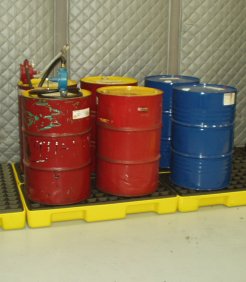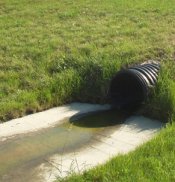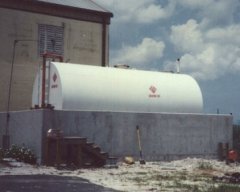Spill Prevention Updates
Spill Planning and Response
A recurring question often arises when we prepare Spill Prevention, Control and Countermeasure (SPCC) Plans for clients who load or unload tankers, deliver oils to customer locations, or maintain a fleet of tanker trucks or railroad cars that may or may not remain at their facilities for a time. Are these road or rail tankers subject to SPCC requirements when they're parked at the facility? And so, do we need to count the tanker capacity when determining if the SPCC rule even applies?
On December 11, 2018, the U.S. Environmental Protection Agency (EPA) and the Department of the Army (Army) proposed a revised definition for "waters of the United States," intended to establish the scope of federal regulatory authority under the Clean Water Act in a more clear and understandable way.
The US Environmental Protection Agency (EPA) has issued its proposed rulemaking pertaining to the issuance of regulations for the prevention of spills or releases of Clean Water Act (CWA) hazardous substances. The proposal, published in the June 25 Federal Register, concludes that no additional regulatory requirements are necessary at this time.
The Florida legislature has now codified the Public Notice of Pollution requirements at Section 403.077, Florida Statutes, effective July 1, 2017. The statutory requirement addresses what were the two issues of contention raised in the emergency rule: What is "pollution" and what are the threshold amounts that trigger the notification requirements?
Additional information about the EPA Oil Program and the SPCC regulations can be found at the website http://epa.gov/oilspill. For additional guidance and assistance with spill prevention, control and countermeasure plan requirements, please contact us.
-
Previous Updates
Compliance Tip: Defining Your Facility for SPCC Planning
The November 2008 amendments to Spill Prevention, Control and Countermeasure (SPCC) Plan requirements provided facility operators with flexibility in defining the extent of the facility to be addressed in an SPCC Plan. This flexibility can be particularly helpful for large properties or installations, such as farms, multi-structured industrial plants and university campuses, where several buildings or locations may be used for storage and management of oil and other petroleum products.
The rule amendments redefined the term "facility" to allow the owner or operator to designate operations in or on contiguous or non-contiguous lands, properties, buildings and so forth as separate facilities for the purpose of compliance with the regulations...
Revisions to Spill Prevention, Control and Countermeasure Requirements
The US Environmental Protection Agency has extended the compliance date for facilities to meet amended Spill Prevention, Control and Countermeasure Plan requirements. All facilities, including farms, must prepare or amend and implement an SPCC Plan by November 10, 2010.
Facilities that were in operation before August 16, 2002, must of course continue to maintain and implement their existing SPCC Plans until required to revise and implement their Plans under the amended regulations.
In December 2008, the EPA amended the SPCC rule in order to provide increased clarity, to tailor requirements to particular industry sectors, and to streamline certain requirements for those facility owners or operators subject to the rule. These amendments will become effective on January 14, 2010.
Specifically, this amended rule: exempts hot-mix asphalt (HMA), pesticide application equipment and related mix containers, and heating oil containers at single-family residences from the SPCC rule; amends the definition of "facility" to clarify the existing flexibility associated with describing a facility's boundaries; amends the facility diagram requirement to provide additional flexibility; defines "loading/unloading rack" to clarify the equipment subject to the provisions for facility tank car and tank truck loading/unloading racks, as well as amends the provisions for this equipment; provides streamlined requirements for a subset of qualified facilities; amends the general secondary containment requirement to provide more clarity; exempts non-transportation-related tank trucks from the sized secondary containment requirements; amends the security requirements; amends the integrity testing requirements to allow greater flexibility in the use of industry standards; amends the integrity testing requirements for containers that store animal fats or vegetable oils and meet certain criteria; streamlines a number of requirements for onshore oil production facilities; and exempts underground oil storage tanks at nuclear power generation facilities.
-
Definition of "Navigable Waters"
This November 2008 ruling restores the 1973 SPCC rule definition of "navigable waters" as follows: The term "navigable waters" of the United States means "navigable waters" as defined in section 502(7) of the Federal Water Pollution Control Act, and includes: (1) All navigable waters of the United States, as defined in judicial decisions prior to passage of the 1972 Amendments to the FWPCA (Pub. L. 92-500), and tributaries of such waters; (2) Interstate waters; (3) Intrastate lakes, rivers, and streams which are utilized by interstate travelers for recreational or other purposes; and (4) Intrastate lakes, rivers, and streams from which fish or shellfish are taken and sold in interstate commerce.
-
Streamlined Requirements for Qualified Facilities
This February 2007 final rule describes streamlined options for specifically qualified facilities and exemptions from the SPCC regulations for certain vehicle fuel tanks and other on-board bulk oil storage containers. The revised rule also exempts mobile refuelers from the sized secondary containment requirements for bulk storage containers, and removes requirements for animal fats and vegetable oils that pertain to onshore and offshore oil production facilities, oil drilling and workover facilities.
The amendments (a) provide the option for owners and operators of facilities that store 10,000 gallons of oil or less and meet other qualifying criteria to self-certify their SPCC Plans in lieu of review and certification by a Professional Engineer; (b) provide an alternative to the general secondary containment requirement without requiring a determination of impracticability for facilities that have particular types of oil-filled equipment; (c) exempt certain vehicle fuel tanks and other on-board bulk oil storage containers used for motive power; and (d) exempt mobile refuelers from the sized secondary containment requirements for bulk storage containers.
The amendments also extended the SPCC compliance dates for farms until a future rule can specifically address how farms should be regulated under the SPCC rule.
The latest rule amendments did not remove any regulatory requirement for owners or operators of facilities in operation before August 16, 2002, to have developed, implemented and maintained a SPCC plan in accordance with the SPCC regulations then in effect. Such facilities continue to be required to maintain their plans until the applicable dates for amending and implementing their existing plans.
-
Further information is available at the EPA oil spill prevention website. For additional guidance and assistance with spill prevention, control and countermeasure plan requirements, please contact us.
-
More Information
Check back for more information on Oil Spill Prevention and related requirements, and for guidance and tools for implementing a Spill Prevention, Control and Countermeasures (SPCC) Plan at your facility.




